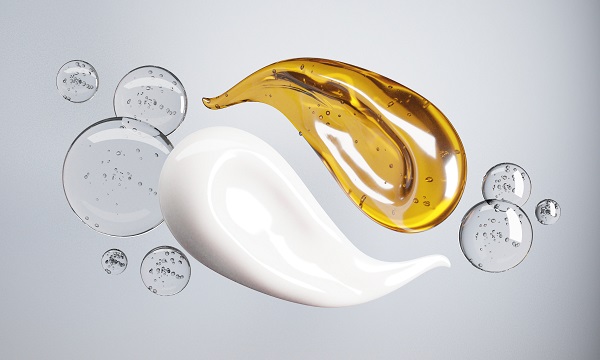Emulsifiers: Secret Ingredients for Accomplishing Completely Combined Formulas
Emulsifiers play a vital duty in producing secure combinations of immiscible fluids, such as oil and water. Their one-of-a-kind residential properties permit them to lower surface area stress, which is essential for harmony in numerous formulations. Understanding the distinctions in between artificial and natural emulsifiers can affect item top quality considerably. As markets increasingly seek to enhance texture and life span, the option procedure for the best emulsifier ends up being extremely important. What variables should be taken into consideration in this essential selection?
Recognizing Emulsifiers: What They Are and Exactly how They Function
Although emulsifiers may appear like a simple addition to solutions, they play an essential duty in maintaining mixtures of components that usually do not mix well, such as oil and water. These substances operate by minimizing surface area stress at the interface between immiscible fluids, allowing them to blend even more consistently. Emulsifiers have both hydrophilic (water-attracting) and lipophilic (oil-attracting) homes, which allow them to anchor themselves at the boundary of the two phases. By doing so, they produce a protective barrier that stops the beads of one liquid from coalescing right into bigger masses, thus preserving a steady solution. The efficiency of an emulsifier relies on its molecular structure, which affects its ability to stabilize mixtures. In various applications, from food products to cosmetics, emulsifiers ensure a regular structure and look, boosting both performance and consumer appeal. Their relevance can not be overstated in attaining well-blended solutions.
Sorts of Emulsifiers: Synthetic vs. natural
Emulsifiers can be extensively classified into two kinds: natural and artificial, each offering unique benefits and applications. Natural emulsifiers, derived from plant or pet resources, consist of casein, periodontal, and lecithin arabic (emulsifiers). These emulsifiers are commonly preferred in clean-label and natural items because of their marginal processing and biocompatibility. Their mild nature makes them ideal for delicate solutions, specifically in food and cosmetics

On the other hand, artificial emulsifiers such as mono- and diglycerides, and polysorbates are produced with chemical procedures. They are commonly utilized in commercial applications due to their stability and performance in developing emulsions. Artificial emulsifiers typically exhibit superior performance in extreme problems, such as heats or differing pH degrees. The choice between artificial and all-natural emulsifiers greatly relies on the specific solution needs, regulatory considerations, and customer preferences, affecting their reliable application in different industries.
Functions of Emulsifiers in Food and Aesthetic Solutions
The duty of emulsifiers prolongs beyond plain stablizing; they are basic in achieving the preferred texture, rack, and look life of food and cosmetic products. In food formulas, emulsifiers assist blend oil and water, producing consistent and smooth textures crucial for sauces, dressings, and dairy products. They reduce surface area tension, improving the security of emulsions, which protects against splitting up and lengthens quality.
In cosmetics, emulsifiers ensure that ingredients, such as oils and water, mix perfectly, boosting and offering a pleasurable feel application. emulsifiers. They add to the item's viscosity and spreadability, essential for lotions, lotions, and lotions. Additionally, emulsifiers can envelop energetic ingredients, boosting their distribution and efficiency in formulas. By controlling appearance and boosting sensory characteristics, emulsifiers play an important role in meeting customer expectations in both food and cosmetic sectors, guaranteeing products are not only appealing yet likewise functionally efficient
Selecting the Right Emulsifier for Your Product

In addition, the target application-- whether for food, cosmetics, or drugs-- will influence the choice. As an example, food-grade emulsifiers should comply with safety and security guidelines, while aesthetic emulsifiers might call for skin compatibility. Reviewing elements such as HLB (Hydrophilic-Lipophilic Equilibrium) assists in forecasting emulsifier actions in details solutions. Eventually, a complete analysis of both regulatory considerations and useful needs is vital to select the most reliable emulsifier, ensuring the final product fulfills the preferred top quality and stability standards.

Tips for Successful Solution Formation and Security
Achieving successful solution formation and security requires careful focus to numerous vital variables. Initially, the choice of emulsifier plays a critical role; it needs to work with the oil and water stages to assure efficient stablizing. Second, the proportion of oil to water should be well balanced, as an improper proportion can bring about instability. Third, the mixing procedure ought to be controlled; high shear blending can aid attain smaller sized bead sizes, improving security.
Temperature level additionally influences emulsion security; preserving suitable temperatures during formula protects against premature separation. Furthermore, incorporating stabilizers such as thickeners can further enhance viscosity, minimizing the chance of phase separation. Lastly, performing comprehensive security tests after solution will help recognize potential problems, permitting changes before last production. By adhering to these guidelines, formulators can accomplish trusted and consistent emulsions that keep their preferred residential properties in time.
Often Asked Questions
Can Emulsifiers Be Utilized in Vegan Formulations?
Yes, emulsifiers can be utilized in vegan formulations. Numerous plant-based emulsifiers, such as lecithin from soy or sunflower, give reliable mixing without animal-derived active ingredients, making them appropriate for a selection of vegan products.
What Are Typical Allergens in Emulsifiers?
Usual allergens in emulsifiers consist of soy, dairy products, and eggs, as particular emulsifiers are obtained from these sources. In addition, some individuals may react to additives or preservatives made use of along with emulsifiers in different formulas.

Just How Do Emulsifiers Impact Life Span of Products?
Emulsifiers improve product stability by preventing separation Homepage of components, consequently expanding life span. They minimize spoilage triggered by microbial growth and oxidation, resulting in extended freshness and enhanced high quality in different food and aesthetic formulas.
Are There Any Health Concerns Connected With Emulsifiers?
Study suggests potential health problems connected with emulsifiers, including gut microbiome changes and swelling. While regulatory bodies generally regard them risk-free, ongoing researches proceed to explore long-term results on health and wellness and overall health.
Can Emulsifiers Improve Flavor or Fragrance in Formulations?
Emulsifiers can improve flavor and fragrance in formulas by improving active ingredient diffusion and stability. This leads to a more consistent product, permitting tastes to meld properly, eventually leading to a much more hop over to these guys enjoyable sensory experience for customers.
Emulsifiers may appear like a simple enhancement to formulations, they play an essential function in stabilizing blends of ingredients that normally do not blend well, such as oil and water. In food solutions, emulsifiers help mix oil and water, creating smooth and consistent structures crucial for sauces, dressings, and dairy items. Food-grade emulsifiers should conform with safety and security policies, while aesthetic emulsifiers may need skin compatibility. Usual allergens in emulsifiers include soy, milk, and eggs, as specific emulsifiers are acquired from these sources. Emulsifiers can improve taste and fragrance in formulations by enhancing active ingredient dispersion and stability.